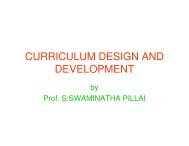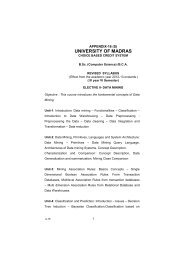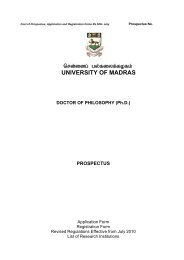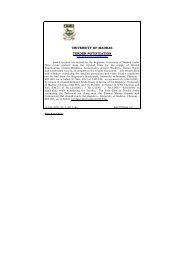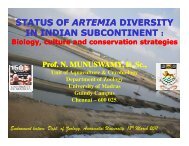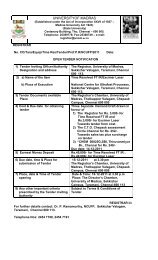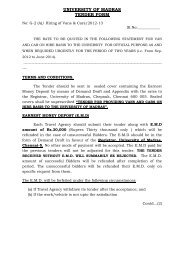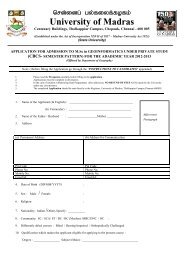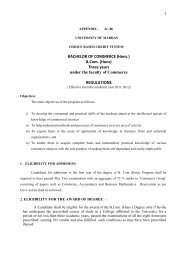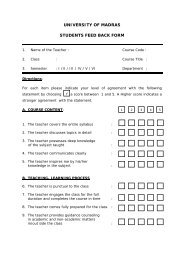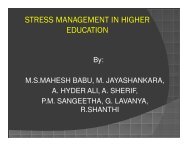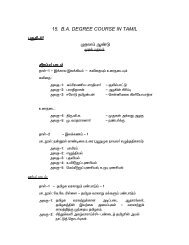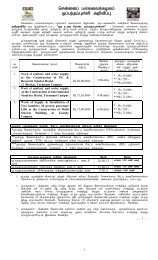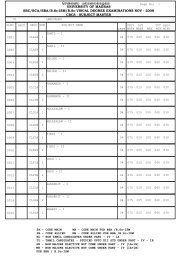School of Historical Studies - University of Madras
School of Historical Studies - University of Madras
School of Historical Studies - University of Madras
Create successful ePaper yourself
Turn your PDF publications into a flip-book with our unique Google optimized e-Paper software.
SCHOOL OF HISTORICAL STUDIES<br />
The <strong>School</strong> <strong>of</strong> <strong>Historical</strong> <strong>Studies</strong> consists <strong>of</strong> Department <strong>of</strong> Indian History and Department <strong>of</strong> Ancient<br />
History and Archaeology.<br />
The <strong>University</strong> <strong>of</strong> <strong>Madras</strong> created the department <strong>of</strong> Indian History and Archaeology as the first faculty<br />
<strong>of</strong> the <strong>University</strong> in 1914 and it was headed successively by eminent historians like Dr.S.Krishnaswamy Iyengar,<br />
Pr<strong>of</strong>.K.A.Nilakanta Sastry, Pr<strong>of</strong>.K.K.Pillay and others. The department was bifurcated into departments <strong>of</strong> Indian<br />
History and Ancient History and Archaeology in 1959. Dr.T.V.Mahalingam was the first Pr<strong>of</strong>essor <strong>of</strong> Ancient<br />
History and Archaeology, a renowned Archaeologist and Epigraphist.<br />
The Department <strong>of</strong> Ancient History and Archaeology has special interests in Epigraphy and<br />
Numismatics, Tamil Culture and Applied Archaeology. It <strong>of</strong>fers Masters and . programmes.<br />
The Department <strong>of</strong> Indian History specializes on Economic History and Urban <strong>Studies</strong>. It <strong>of</strong>fers Masters,<br />
M.Phil and . programmes.<br />
Faculty<br />
Dr.A.Ekambaranathan,<br />
- Chairperson<br />
Ancient History and Archaeology<br />
A. Ekambaranathan, - Pr<strong>of</strong>essor and Head<br />
P.D. Balaji,<br />
- Lecturer<br />
Indian History<br />
G. Venkataraman, - Pr<strong>of</strong>essor and Head<br />
S. Kuppusamy, - Lecturer<br />
S.S.Sundaram<br />
- Lecturer<br />
M.A. ANCIENT HISTORY AND ARCHAEOLOGY<br />
No Course title Credit C/E Faculty<br />
I Semester<br />
HIS C 001 History <strong>of</strong> South India up to A.D. 1565. 4 C P.Jayakumar<br />
HIS C 002 Pre history <strong>of</strong> India 4 C P.D.Balaji<br />
HIS C 003 Principles and Methods <strong>of</strong> Archaeology 4 C A.Ekambaranathan<br />
HIS E 001 Indian Paintings 3 E J. Soundararajan<br />
HIS E 002 Archaeological <strong>Studies</strong> in India 3 E A.Ekambaranathan<br />
HIS E 003 Introduction to Archaeology 3 E P.D.Balaji<br />
HIS E 004 Applied Archaeology 3 E J. Soundararajan<br />
II Semester<br />
HIS C 004 History <strong>of</strong> North India up to A.D. 1206. 4 C J. Soundararajan<br />
HIS C 005 Proto history <strong>of</strong> India 4 C P.D.Balaji<br />
HIS C 006 Field work and Exploration 4 C A.Ekambaranathan<br />
HIS E 005 South Indian Ceramics 3 E A.Ekambaranathan<br />
HIS E 006 Cultural History <strong>of</strong> India upto A.D. 750. 3 E P.D.Balaji<br />
HIS E 007 Early <strong>Historical</strong> Archaeology <strong>of</strong> Tamil Nadu. 3 E P.Jayakumar<br />
HIS E 008 An Introduction to the Cultural History <strong>of</strong> Tamil Nadu. 3 E J.Soundararajan<br />
III Semester<br />
HIS C 007 History <strong>of</strong> Indian Architecture and Sculpture 4 C A.Ekambaranathan<br />
HIS C 008 Indian Epigraphy and Palaeography 4 C P.Jayakumar<br />
HIS C 009 Indian Numismatics 4 C J.Soundararajan<br />
HIS E 009 Cultural History <strong>of</strong> Tamil Nadu up to A.D. 1565 3 E P.D.Balaji<br />
HIS E 010 Epigraphical <strong>Studies</strong> in India 3 E P.Jayakumar<br />
HIS E 011 South Indian Coins 3 E J.Soundararajan<br />
HIS E 012 History <strong>of</strong> Architecture in Tamil Nadu 3 E A.Ekambaranathan
IV Semester<br />
HIS C 010 Museology 4 C P.D.Balaji<br />
HIS C 011 Iconography 4 C A.Ekambaranathan<br />
HIS C 012 Excavation and Report 10 C All Faculty<br />
HIS E 013 Museum Technique 3 E P.D.Balaji<br />
HIS E 014 Tourism in India 3 E J.Soundararajan<br />
HIS E 015 Archaeological Conservation 3 E P.Jayakumar<br />
COURSE CONTENTS<br />
HIS C 001 History <strong>of</strong> South India up to A.D. 1565. 4 C P.Jayakumar<br />
Course Objective<br />
A comprehensive study <strong>of</strong> political, social and cultural history <strong>of</strong> South India from 3rd century B.C. to<br />
A.D. 1565. The political achievements <strong>of</strong> the Sangam dynasties, Pallavas, Pandyas and Cholas in Tamil Nadu are<br />
highlighted. The achievements <strong>of</strong> the Deccan kingdoms like the Satavahanas, the Chalukyas Rashtrakutas are also<br />
studied. The various feudatory dynasties and their role in the political and social evolution in South India are also<br />
studied. The growth <strong>of</strong> the State in South India, and the economy are included<br />
.<br />
Unit 1: Sources - Archaeological, literary and epigraphical – Pre Sangam age - Sangam Age: kingdoms <strong>of</strong> the<br />
Sangam period - Cholas, Cheras, Pandyas; Satavahanas: political and cultural achievements.<br />
Unit 2: Pallavas and Pandyas: Political and Social history; Western Chalukyas and Rashtrakutas –<br />
Feudatories: Velir, Banas, Vaidumbas, Paluvettariayars, Nolambas.<br />
Unit 3: The Cholas: political, social and economic achievements; Later Pandya rule – Kadavarayas, Telugu<br />
Chodas – Muslim invasions.<br />
Unit 4: Chalukyas <strong>of</strong> Kalyani, Hoysalas, Eastern Chalukyas, Kakatiyas; political and social conditions –<br />
relations with Tamil country.<br />
Unit 5: Establishement <strong>of</strong> Vijayanagara rule in South India – achievements - Changes in politico social<br />
conditions; Bahmini Sultanate – Developments in Deccan and social conditions.<br />
HIS C 002 Pre history <strong>of</strong> India 4 C P.D.Balaji<br />
Course Objective<br />
A detailed study <strong>of</strong> the earliest cultures <strong>of</strong> India till the dawn <strong>of</strong> history. Study is based on various<br />
archaeological sources and their interpretation. The origin and evolution <strong>of</strong> man and his habitat and the making <strong>of</strong><br />
stone tools, techniques, distribution, and cultural background <strong>of</strong> the stone age peoples from the old stone age to the<br />
mesolithic ages in India are included.<br />
Unit 1: Definition and scope <strong>of</strong> prehistory - History <strong>of</strong> Indian prehistory - sources: stone tools, bones and<br />
fossils-interpretation.<br />
Unit 2: Geology - its importance to prehistory - pleistocene age - ice ages; Stone age tools - general features <strong>of</strong><br />
tool techniques.<br />
Unit 3: Palaeolithic age - Terraces: Soan and Kortalaiyar valleys - sequence <strong>of</strong> cultures - Early works and<br />
authorities: R. Bruce Foote, De Terra and Patterson, V. D. Krishnaswamy and others.<br />
Unit4: Lower palaeolithic cultures - distribution and tool types and techniques; Middle palaeolithic cultures -<br />
distribution and tool types and techniques; Upper palaeolithic cultures - distribution and tool types and<br />
techniques. Life <strong>of</strong> the palaeolithic people.<br />
Unit 5: Mesolithic age - transformation and change - cultural distribution and tool types and techniques - life <strong>of</strong><br />
the mesolithic people - end <strong>of</strong> the mesolithic cultures.<br />
HIS C003 Principles and Methods <strong>of</strong> Archaeology E 2 1 0 3 A.Ekambaranathan<br />
Course Objective :<br />
The course deals with the scope <strong>of</strong> archaeology and studies different types <strong>of</strong> archaeological<br />
investigations. The development <strong>of</strong> archaeology from the antiquarian methods to the scientific investigations.<br />
Various sciences useful for archaeological methods and investigations are projected. The basic principles and<br />
methods followed in field work and excavation <strong>of</strong> ancient sites and proper documentation <strong>of</strong> various artifacts. The<br />
methods <strong>of</strong> conservation <strong>of</strong> antiquities and their interpretation. Dating <strong>of</strong> the antiquities and the preparing the<br />
report <strong>of</strong> excavation for publication.<br />
Unit 1: Definition - Scope and value <strong>of</strong> Archaeology - History <strong>of</strong> Archaeology – Antiquarianism –<br />
Development <strong>of</strong> Indian Archaeology<br />
Unit 2: Types <strong>of</strong> archaeology – Ethno archaeology, Biblical archaeology, Salavage archaeology; Useful<br />
sciences- Biological, Physical and Chemical sciences – other sciences.
Unit 3: Methods <strong>of</strong> Exploration – Field survey, Topo maps, Trail digging; Excavation – Equipment and Staff;<br />
methods – planning, stratigraphy, collection <strong>of</strong> antiquities, documentation - Remote sensing, Underwater<br />
Archaeology<br />
Unit 4: New Archaeology, Under water Archaeology, Remote sensing,; Dating methods – relative and absolute<br />
methods.<br />
Unit 5: Documentation; conservation – physical and chemical; Preservation in museum; Publication <strong>of</strong> report –<br />
preparation <strong>of</strong> charts, drawings and photographs.<br />
HIS E001 Indian Paintings E 2 1 0 3 J.soundararajan<br />
Course Objective:<br />
To study the rich heritage <strong>of</strong> Indian Painting. To know about the historical development <strong>of</strong> Indian<br />
painting styles from the earliest times to A.D. 1600. <strong>Studies</strong> the regional and dynastic contribution to the art <strong>of</strong><br />
painting, eeflection <strong>of</strong> society and its impact on painting.<br />
Unit 1: Origin and development <strong>of</strong> painting in India : Early paintings - paintings <strong>of</strong> different materials –<br />
early references to paintings in literature.<br />
Unit 2: Pre Mauryan Paintings – Mauryan and Pre Gupta paintings; Paintings in South India – Sangam<br />
and Satavahana paintings.<br />
Unit 3: Vakataka paintings – Ajanta; Pallava and Pandya Paintings – Kanchipuram and Sittannavasal.<br />
Unit 4: Chola paintings- Brihadiswara temple; Rashtrakuta and Hoysala paintings.<br />
Unit 5: Vijayanagara Paintings – Lepakshi, Hampi and Srirangam. Nayak paintings – Maratta, Rajaput and<br />
Mughal paintings.<br />
HIS E002 Archaeological <strong>Studies</strong> in India E 2 1 0 3 A.Ekambaranathan<br />
Course Objective :<br />
An historical study <strong>of</strong> the growth <strong>of</strong> archaeological research in the Indian Sub-continent. Early<br />
archaeological discoveries-formation <strong>of</strong> the Asiatic society <strong>of</strong> India - Establishment <strong>of</strong> the Archaeological Survey<br />
<strong>of</strong> India and its functions and studied. The nature <strong>of</strong> conservation and the antiquarian laws relating to monuments<br />
are studied. Recent developments in the various branches <strong>of</strong> archaeological studies are given importance.<br />
Unit 1: Early attempts <strong>of</strong> discoveries and studies-Foreign and Indian scholar’s contributions – Schilimann,<br />
Pitts Rivers. Development <strong>of</strong> Indian Archaeology – Archaeological Survey <strong>of</strong> India – its functions.<br />
Unit 2: Types <strong>of</strong> Archaeology – Ethno archaeology, Biblical archaeology, Salvage Archaeology; Useful<br />
sciences – Biological, Physical and Chemical sciences, other sciences.<br />
Unit 3: Archaeological Exploration: methods; Excavation: technique, materials, staff; stratigraphy and<br />
documentation; preparation <strong>of</strong> excavation report.<br />
Unit 4: Archaeological Conservation – basic methods <strong>of</strong> conservation: organic and inorganic objects; –<br />
Archaeological Museums - Central, State and Private museums-their functions.<br />
Unit 5: Education and research - recent developments – New Archaeology; Under water Archaeology,<br />
Remote sensing.<br />
HIS E003 Introduction To Archaeology E 2 I 0 3 P.D.Balaji<br />
Course Objective<br />
An introductory course on various aspects <strong>of</strong> Archaeology. Deals with the importance <strong>of</strong> archaeological<br />
studies, its relationship with other sciences. The several branches <strong>of</strong> archaeology like ethno archaeology and<br />
salvage archaeology are introduced. Aspects <strong>of</strong> archaeological field-work and excavation techniques are also<br />
introduced – Epigraphic-Numismatic-monuments-sculptural aspects are studied. Recent developments in<br />
Archaeology.<br />
Unit 1:<br />
Unit 2:<br />
Unit 3:<br />
Unit 4:<br />
Unit 5:<br />
Scope – Importance <strong>of</strong> Archaeology - Types <strong>of</strong> archaeology: Ethno archaeology, Salvage<br />
archaeology; Relation with other sciences - Biological, Chemical, Physical and other sciences.<br />
History <strong>of</strong> Archaeology in India- Archaeological Survey <strong>of</strong> India, state and Universities in<br />
archaeological studies.<br />
Exploration <strong>of</strong> ancient Sites: methods and techniques; Excavation: equipment and Staff, methods<br />
<strong>of</strong> excavation, documentations. Archaeological conservation: chemical and Physical; Conservation<br />
<strong>of</strong> Monuments: techniques.<br />
Other branches <strong>of</strong> Archaeology: Pre and protohistoric Archaeology, Epigraphy, Numismatics, Art<br />
and Architecture and Sculpture.<br />
Recent developments in Archaeology: New Archaeology: concepts, Underwater archaeology,<br />
Remote Sensing, computer methods.
HIS E004 Applied Archaeology E 2 1 0 3 A.Ekambaranathan<br />
Course Objective<br />
It is an application-oriented study - Deals with the definition and scope with a detailed study on the<br />
various methods <strong>of</strong> applications <strong>of</strong> archaeology. It also deals with preservation and conservation <strong>of</strong> archaeological<br />
materials. Various applications like the display methods in museums and their utility are focussed. Various<br />
monuments are included for study, with reference to tourism in India. The laws relating to archaeology and their<br />
applicability are also forms part <strong>of</strong> the study.<br />
Unit 1:<br />
Unit 2:<br />
Unit 3:<br />
Unit 4:<br />
Unit 5:<br />
Definition and purpose <strong>of</strong> applied Archaeology - various applications <strong>of</strong> archaeology - supportive<br />
disciplines - sciences - chemical, physical and biological sciences.<br />
Conservation <strong>of</strong> artefacts -various methods - Preservation - Treatment <strong>of</strong> excavated objects - in the<br />
site and Museum, Chemical cleaning and preservation<br />
Museums; Museums in India- different types <strong>of</strong> Museums - nature and their functions, cultural and<br />
educational functions <strong>of</strong> museum - museum administration.<br />
Monuments - different types <strong>of</strong> monuments - secular and religious; Conservation and preservation<br />
: Some techniques; Travel and tourism in India - cultural monuments - Archaeology and tourism -<br />
guide service.<br />
Archaeological Laws - interpretation - implementing agencies, Archaeological Survey <strong>of</strong> India,<br />
State Government - Police and Administration.<br />
HISC C004 History <strong>of</strong> North India up to A.D. 1206 C 3 1 0 4 J.Soundararajan<br />
Course Objective<br />
A survey <strong>of</strong> political, social and economic condition <strong>of</strong> India from the Vedic age to the establishment <strong>of</strong><br />
Delhi Sultanate. It enables the students to understand the different cultural developments and changes that had<br />
taken place during Vedic age, Mauryas, Kushans, Guptas, Harsha, Rajputs and Delhi Sultanate. And it also<br />
focused on the assimilation <strong>of</strong> various foreign cultures in India from the earliest times.<br />
Unit 1: Sources – Vedic culture – economic,social organization and religion –Jainism, Buddhism – Rise <strong>of</strong><br />
Maghadha – Persian, Greek invasions.<br />
Unit 2: Mauryan empire: Administration; Post Mauryan period - society, economy, culture and religion –<br />
Sungas and their Contributions - Indo Greek kingdoms - cultural fusion.<br />
Unit 3: Rise <strong>of</strong> the Gupta empire – administration – social and economic condition – Gupta literature,<br />
developments in science; Invasion <strong>of</strong> Huns and decline <strong>of</strong> the guptas; Vakatakas and their contribution<br />
–<br />
Unit 4:<br />
Unit 5:<br />
Pushyabhutis- Harsha – Arab conquest <strong>of</strong> Sind – Cultural and literary contributions - foreign contacts.<br />
Rise <strong>of</strong> Kanuaj - Rule <strong>of</strong> the Palas, Chandellas, Prathiharas, Chauahans ane Paramaras: their<br />
contribution to Indian culture : Md.Gazni – Md. Ghori – its impact on Indian culture - Establishment<br />
<strong>of</strong> the Delhi Sultanate.<br />
HIS C005 Proto History <strong>of</strong> India C 3 1 0 4 P.D.Balaji<br />
Course Objective<br />
A study <strong>of</strong> cultures <strong>of</strong> the post Stone ages to the beginning <strong>of</strong> the historical period. The emergence <strong>of</strong> the<br />
neolithic age and the distribution and the cultural development during the period. The development <strong>of</strong> early<br />
forming cultures, Indus valley civilization and the Chalcolithic condition in India. The transformation to the Iron<br />
age and megalithic cultures with the type <strong>of</strong> burials and their cultural contributions are studied.<br />
Unit 1:<br />
Unit 2:<br />
Unit 3:<br />
Unit 4:<br />
Unit 5:<br />
Neolithic age - Definition - origin and evolution - Tools and techniques - Eastern, northern and<br />
southern neolithic cultures - distribution and tools - pottery - life and economy.<br />
Early farming cultures in Baluchistan and Sind - Distribution- pottery and artefacts- The Banas culture<br />
- Extent and distribution- tools and economy<br />
Harappan culture in north west India: Harappa, Kalibangan, Lothal; Chalcolithic cultures <strong>of</strong> Central<br />
and Western India - Daimabad, Nevasa.<br />
Painted Grey ware culture in the Ganga-Yamuna valley; The Iron age cultures: Northern Black<br />
Polished ware culture-life and economy.<br />
Megalithic culture in Deccan and south India - distribution - Burial types, Chamber tombs, Dolmens,<br />
Cists etc.; Brahmagiri, Sanur, Amirthamangalam, Adichhcnallur - Grave goods - Pottery - life and<br />
economy.<br />
HISC 006 Field Work And Exploration C 1 1 2 4 A.Ekambaranathan<br />
Course Objectives<br />
A field work relating to archaeological exploration. The course is divided into three sections as follows:<br />
1. Visits to any three <strong>of</strong> the prehistoric and Early historcal Sites:
1. Attirampakkam, 2.Gudiyam, 3. Nambakkam, 4. Sanur, 5. Amirthmangalam, 6. Appukkallu, 7.<br />
Mallapadi, 8. Paiyampalli., 9. Adichchanallur, 10. Sittannavasal, 11. Kodumanal, 12. Tiruvakkarai, 13.<br />
Sayarpuram, 14. Dharmapuri 2. Visits to any three <strong>of</strong> the Temples for art, architectural and sculptural study: 1.<br />
Shore temple (Mamallapuram), 2. Five rathas ( Mamallapuram), 3. Cave temples (Mamallapuram), 4. Kailasanatha<br />
temple (Kanchipuram), 5. Brihadiswara temple (Gangaikondacholapuram), 6. Brihadisvara temple (Thanjavur), 7.<br />
Jalakandeswara temple (Vellore Fort), 8. Siva temple (Virincipuram), 9. Varadharaja Temple (Kanchipuram), 10.<br />
Nageswaraswami temple (Kumbakonam), 11.Airavatesvara Temple (Darasuram), 12.Muvar Koil (Kodumbalur),<br />
13. Vijyalaya cholisvaram (Narthamalai), 14. Lower and Upper Rock cut Temples (Tiruchirappalli), 15. Cave<br />
Temple (Tirupparankunram), 16. Cave Temple (Anamalai), 17. Vettuvan Koil (Kalugumalai), 18. Tiruvaliswaram<br />
Temple (Ambasamudram).<br />
3.Practical examination based on the field visits.<br />
HISE 005 South Indian ceramics E 2 1 0 3 A. Ekambaranathan<br />
Course Objective<br />
Deals with the origin and development <strong>of</strong> pottery in South India. The introduction <strong>of</strong> pottery in Late<br />
stone age and the changes brought about in the life and style <strong>of</strong> man are stressed. Importance <strong>of</strong> pottery in field<br />
archaeology, different types <strong>of</strong> earthern ware found in south India including Roman and Chinese potteries their<br />
role in trade and commerce etc. are dealt with.<br />
Unit 1: Importance <strong>of</strong> ceramics - origin <strong>of</strong> pottery - neolithic pottery: hand made and wheel made -<br />
Technology.<br />
Unit 2:<br />
Unit 3:<br />
Unit 4:<br />
Unit 5 :<br />
Types <strong>of</strong> Ceramics - Early pottery in South India: Iron Age ceramics : Burial pottery and habitation<br />
pottery - Manufacture and Technique; Distribution and Chronology - Shapes.<br />
Ceramics <strong>of</strong> the Early historical period: Russet coated and Painted ware, Black and Red ware, Red<br />
slipped ware - Coarse red ware : Distribuiton.<br />
Foreign Ceramics – Roman pottery, Arretine, Rouletted ware, amphora; Other foreing ceramics; trade<br />
and commerce.<br />
Documentation - preservation <strong>of</strong> ceramics; Grafitti on pottery, Painted designs on pottery.<br />
HIS E006 Cultural history <strong>of</strong> India up to A.D. 750 E 2 1 0 3 P.D.Balaji<br />
Course Objective<br />
The study provides a comprehensive picture <strong>of</strong> the cultural development in India from the Stone ages to<br />
the fall <strong>of</strong> Harsha. It deals with the social, economic, religious history <strong>of</strong> the people and their social customs and<br />
conventions in north as well as south India. <strong>Historical</strong> and cultural developments <strong>of</strong> the following periods <strong>of</strong><br />
history: Vedic age, Mauryan rule, Kushan, Guptas, Harsha, Sangam kingdoms, Satavahana rule, Chalukyas <strong>of</strong><br />
Badami and Pallavas; Contributions and highlights <strong>of</strong> their rule.<br />
UNIT 1: Life <strong>of</strong> the Paleoliths, Mesoliths, Neoliths, Chalcoliths and Megaliths-burial- practices - life and<br />
economy.<br />
UNIT 2: Vedic Age- social formation - caste system- brahmanism- post Vedic age- Puranas, persian invasion -<br />
Development <strong>of</strong> Buddhism and Jainism - rise <strong>of</strong> Madagha.<br />
UNIT 3: Satavahans - social, Cultural and Economic aspects - Post Satavahana dynasties - Ikshvakus. : Sangam<br />
age - Dynasties - Social, cultural and Economic aspects- Foreign trade - art and Architecture -<br />
literature.<br />
UNIT 4: Gupta period - Literature and scientific developments - western Chalukyas, Pallavas and Pandyas - Art<br />
and Architecture – Literature,, Economy and trade.<br />
UNIT 5: Post Gupta period - Harshavardhana- invasion <strong>of</strong> the Muslims - Development and spread <strong>of</strong> culture in<br />
South East Asia.<br />
HIS E007 Early historical archaeology <strong>of</strong> Tamil Nadu E 2 1 0 3 P.Jayakumar<br />
Course Objective<br />
A study <strong>of</strong> cultural history <strong>of</strong> the Pre Iron age cultures in Tamil Nadu. Deals with the origin and<br />
distribution <strong>of</strong> the iron age and Megalithic structures like dolmens and cists. Deals with the important excavations<br />
<strong>of</strong> megaliths. <strong>Studies</strong> the various types <strong>of</strong> pottery, socio economic aspects, trade and technological developments.<br />
Unit 1: Scope and Definition - Sources - Archaeological excavations - artefacts - Sangam Literary traditions.<br />
Unit 2: Pre Iron age conditions - Relations with other regions - Recent studies - Iron age cultures in India -<br />
distribution, social life and economy.
Unit 3: South Indian Megaliths - distribution - Arikamedu, Kavirippattinam, Uraiyur, Kanchipuram, Kodumanal-<br />
construction- burial types, structural grave goods - pottery - economy.<br />
Unit 4: Pottery - Black and red ware, Red ware, Black ware, Foreign pottery.Structures: structural materials -<br />
mud, brick, stone etc., - plan <strong>of</strong> structures- other artefacts.<br />
Unit 5 : Economy - Irrigation and Agriculture - Trade and industries - Technology; Religious ideas - social life<br />
- outside influence.<br />
HIS C008 An introduction to the cultural history<strong>of</strong> Tamilnadu E 2 1 0 3 Guest Faculty<br />
Course Objective<br />
A study <strong>of</strong> cultures <strong>of</strong> the pre megalithic period in Tamil Nadu. the development <strong>of</strong> neolithic culture and<br />
its distribution. The iron age and Megalithic burials are studied. Some <strong>of</strong> the excavations <strong>of</strong> the historical period<br />
like Kavirippumpatinam are studied. The settlement pattern, urbanization etc. are also highlighted.<br />
Unit 1: Introduction to Proto history - definition - sources: excavated artefacts, Literary and inscriptional -<br />
interpretation.- Neolithic and Chaclolithic origins - Distribution and cultural significance.<br />
Unit 2: Iron age cultures in India - distribution, Megaliths - distribution - burial types, structural grave goods -<br />
Early historical period - excavations - Arikkamedu, Kaverippumpattinam, Uraiyur and Kodumanal -<br />
.social life and economy.<br />
Unit 3: Settlement pattern - Structures: structural materials - mud, brick, stone etc., - plan <strong>of</strong> structures -<br />
Pottery - Black and red ware, Red ware, Black ware, Foreign pottery..<br />
Unit 4: Economy - Irrigation and Agriculture - Trade and industries - Technology - Urbanization.<br />
Unit 5: Social and Religious ideas - social life - outside influence.<br />
HIS C007 HISTORY OF INDIAN ARCHITECTURE AND<br />
SCULPTURE<br />
Course Objective<br />
C<br />
3 1 0 4 A. Ekambaranathan<br />
The course deals with the origin and development <strong>of</strong> Art, Architecture and sculptural art from the earliest<br />
times to the medieval period. The various architectural and sculptural styles are studies with a historical<br />
background.<br />
Unit 1: ` Origin and development <strong>of</strong> architecture and sculpture: Indus valley: structures and stone and terracotta<br />
art; Mauryan and Sunga art: Asoka sthambas, Stupas and Stone carvings; Gandhara and Mathura<br />
schools <strong>of</strong> Art: styles <strong>of</strong> Architecture.<br />
Unit 2: Early art and Architecture <strong>of</strong> South India and Deccan - Satavahana, Amaravathi Style: Sangam Art -<br />
Gupta and Vakataka art- Western Indian Cave Architecture - Pallava, Rashtrakuta art - Early Pandy<br />
art: cave and structural art.<br />
Unit 3: Chola art and architecture: Brihadisvara, Darasuram, Gangaikonda cholapuram<br />
Unit 4: Chalukyan art and Architecture; Hoysala art.<br />
Unit 5: Vijayanagara styles <strong>of</strong> art and architecture<br />
HIS C008 INDIAN EPIGRAPHY AND PALAEOGRAPHY C 3 1 0 4 P.Jayakumar<br />
Course Objective<br />
A course on the development <strong>of</strong> Ancient inscriptions and ancient scripts in India. Deals with the origin<br />
and development <strong>of</strong> writing and its development in India from the vedic age to the medieval times. It includes the<br />
developkment <strong>of</strong> ancient scripts like Brahmi, Tamil Brahmi, Grantha and Vatteluttu. It deals with the types <strong>of</strong><br />
ancient inscriptions, and thier study. The study includes a detailed study <strong>of</strong> selected inscriptions and their use for<br />
historical understanding.<br />
Unit 1: Origin <strong>of</strong> writing in general - Ancient systems <strong>of</strong> writing- Origin and history <strong>of</strong> writing in India - Indus<br />
script - decipherments attempts - Antiquity <strong>of</strong> writing in India.<br />
UNIT 2: Asokan Brahmi script - theories <strong>of</strong> origin - history <strong>of</strong> decipherment - palaeography. Kharoshti script -<br />
origin and decline - Development <strong>of</strong> Brahmi script - North Indian scripts - Development <strong>of</strong> script in<br />
Deccan.<br />
Unit 3: Origin <strong>of</strong> writing in South India - History <strong>of</strong> decipherment <strong>of</strong> South Indian scripts- Evolution <strong>of</strong> South<br />
Indian scripts - Tamil-Brahmi script, Tamil and Vatteluttu scripts - Other scripts in South India -<br />
Grantha script, Kannada script, Telugu script and script.<br />
Unit 4: Study <strong>of</strong> Inscriptions: Asokan, Gupta, Satavahana inscriptions. Types <strong>of</strong> inscriptions - format <strong>of</strong> in<br />
scriptions - Tamil Brahmi inscriptions - Pallava, Chola, Pandya, and Vijayanagara inscriptions.<br />
Writing materials - authenticity; eras - Saka, Vikrama, .<br />
Unit 5 : Study <strong>of</strong> Inscriptions - (Inscriptions for study)
HIS C009 INDIAN NUMISMATICS C 3 1 0 4 J.Soundararajan<br />
Course Objective<br />
The study deals with the origin and development <strong>of</strong> coinage and monetary system in ancient India upto<br />
the medieval times. It deals with the Early history and evolution <strong>of</strong> Coinage from the punch marked variety. It<br />
studies the development <strong>of</strong> coins issued by various dynasties and their historical importance. The coin issues <strong>of</strong> the<br />
Indo Greeks, Guptas, Satavahanas, Chola, Chera, Pandya and Vijayanagar rulers and the foreign issues are also<br />
studied.<br />
Unit 1:<br />
Unit 2:<br />
Unit 3:<br />
Unit 4:<br />
Unit 5:<br />
Importance <strong>of</strong> the study <strong>of</strong> Coins - Sources as a sourcs. Coins as a source - their study for the history<br />
<strong>of</strong> South India - Literary references to Coins. Orign, antiquity and development <strong>of</strong> coinage - literary<br />
reference - coinage as a science;<br />
Punch Marked coins - Chronology - distribution symbols their significance - Indo-Greek and Kushana<br />
coins - their impact significance - Gupta coinage - various aspects.<br />
Coins <strong>of</strong> Sangam age - Punch marked coins - Satavahana Coins - Ikshavaku coins - Roman coins<br />
Coins <strong>of</strong> the - Pallavas - Cholas - the Pandyas - Vijayanagaras - their historical values., Chinese Coins<br />
- their significance<br />
Coins <strong>of</strong> the Chalukyas- Hoysalas and Rashtrakutas - Vijayanagar Kings<br />
HIS E009 CULTURAL HISTORY OF TAMIL NADU UP TO A.D. 1565 E 2 1 0 3 P.D.Balaji<br />
Course Objective<br />
A detailed history <strong>of</strong> the Tamil country from the earliest times to the downfall <strong>of</strong> the Vijayanagara<br />
Empire. It covers the history <strong>of</strong> the Stone ages, and the proto and early historical periods. The developments in the<br />
Sangam age, the history <strong>of</strong> the kingdom <strong>of</strong> the Pallavas, and early Pandyas, Cholas, later Pandyas and<br />
Vijayanagara are dealt in this paper. The various cultural developments <strong>of</strong> the Tamil country are also highlighted.<br />
Unit 1:<br />
Unit 2:<br />
Unit 3:<br />
Unit 4:<br />
Unit 5:<br />
Sources – Pre and proto historic cultures – Sangam literature –formation <strong>of</strong> Kingdoms - Social and<br />
Cultural life; Tinai concept; Economy and Trade- Roman trade- decline <strong>of</strong> the Sangam age - Influence<br />
<strong>of</strong> the Northern cultures -Buddhism and Jainism.<br />
Pre Pallava peiod - Satavahana relations -Pallava rule: Bhakti movement – revival <strong>of</strong> Saivism and<br />
Vaishnavism – impact <strong>of</strong> religious Philosophy - Trade and Commerce - Literature.<br />
Chola rule - Development <strong>of</strong> Politics - Urbanization and development <strong>of</strong> cities - Temples, Art and<br />
letters, coinage, Trade and Religion- Decline <strong>of</strong> the Chola rule- Relations with Chalukyas and<br />
Hoysalas - Relations with foreign countries.<br />
Pandya Rule - Religion in South India - Art and Literature - Relations with Sri Lanka - invasion <strong>of</strong><br />
Malik Kafur-Muslim influence- Trade and commerce.<br />
Vijayanagara rule in Tamil country - Establishment and expansion - migrations - Religion - Decline <strong>of</strong><br />
the Vijayanagara Empire - Economy and society - art and letters.<br />
HIS E010 EPIGRAPHICAL STUDIES IN INDIA E 2 1 0 3 P.Jayakumar<br />
Course Objective<br />
An introductory course on the development <strong>of</strong> inscriptions and scripts in India. Deals with the origin and<br />
development <strong>of</strong> scripts and inscriptions and its development in India from the earliest times to the medieval times.<br />
The study includes the methods <strong>of</strong> making the collections, and its use for historical interpretation.<br />
Unit 1:<br />
Unit 2:<br />
Unit 3:<br />
Unit 4:<br />
Unit 5:<br />
Scope <strong>of</strong> Epigraphical studies - importance for the historical and Economic study <strong>of</strong> South India<br />
Development <strong>of</strong> Epigraphical <strong>Studies</strong> - Early attempts <strong>of</strong> dechipherment <strong>of</strong> scripts in India.<br />
Epigraphical collections - Method <strong>of</strong> collection - Agencies involved - Publications<br />
Development <strong>of</strong> Tamil Epigraphy - Brahmi, Kharaoshti and Tamil Brahi scripts - Early inscriptions<br />
Epigraphical Research Analysis - Statistical and other methods - recent works.<br />
HIS E011 SOUTH INDIAN COINS S 2 1 0 3 J.Soundararajan<br />
Course Objective<br />
The study deals with the origin and development <strong>of</strong> coinage and monetary system in south India upto the<br />
medieval times. It deals with the Early history and evolution <strong>of</strong> Coinage from the Sangam age. It studies the<br />
development <strong>of</strong> coins issued by various dynasties and their historical importance. The coin issues <strong>of</strong> the<br />
Satavahanas, Chola, Chera, Pandya, Chalukya, Hoysala and Vijayanagar rulers and foreign issues are also studied.<br />
Unit 1: Scope <strong>of</strong> numismatics studies - Coins as a source - their importance for the history <strong>of</strong> South India -<br />
Epigraphical and Literary references to Coins.
Unit 2:<br />
Unit 3:<br />
Unit 4:<br />
Unit 5:<br />
South Indian Coin studies - Early studies -Development - coin collection - private and Museum<br />
collections.<br />
Coins Symbols- Language - use <strong>of</strong> inscriptional materials - value - metal - coin manufacturing<br />
techniques- coin moulds - coin weights- legends and symbols<br />
Coins <strong>of</strong> the Tamil Country: Sangam age - Punch marked coins - Pallavas - Cholas - Roman, Chinese<br />
Coins - their significance Coins <strong>of</strong> the Pandyas - Vijayanagaras - their historical values<br />
Coins <strong>of</strong> the south India and Deccan : Satavahana Coins - Ikshavabu coins Coins <strong>of</strong> the Chalukyas<br />
Hoysalas -.<br />
HIS E012 HISTORY OF ARCHITECTURE IN TAMIL NADU E 2 1 0 3 A.Ekambaranathan<br />
Course Objective<br />
To focus the importance <strong>of</strong> religious architecture in Tamil Nadu. To have a thorough understanding <strong>of</strong><br />
the development <strong>of</strong> temple architecture commencing from the early centuries <strong>of</strong> the Christian era down to the<br />
medieval times with special emphasis on Pallava , Chola, Pandya and Vijayanagara Architecture.<br />
Unit 1: Sources: Early forms <strong>of</strong> temple architecture -Pre Pallava architecture.<br />
Unit 2: Pallava architecture - Cave and Structural architecture.<br />
Unit 3: Early Pandya architecture - cave and Structural Architecture - Muttaraiyar architecture.<br />
Unit 4: Chola architecture - Brihadisvara Temple, Darasuram, Gangaikonda Cholapuram; Later Pandya<br />
architecture.<br />
Unit 5: Vijayanagara architecture - development <strong>of</strong> Mandapa and Gopura architecture - Nayak architecture -<br />
Secular architecture - forts.<br />
HIS C010 MUSEOLOGY C 3 1 0 4 P. D. Balaji<br />
Course Objective<br />
The paper provides a detail study <strong>of</strong> Museum keeping. It deals with the origin and development <strong>of</strong><br />
Museum and various aspects such as types <strong>of</strong> museums, display system, documentation, various laws passed time<br />
to time to preserve the cultural properties and methods conservation and preservation <strong>of</strong> museum objects.<br />
Unit 1:<br />
Unit 2:<br />
Unit 3:<br />
Unit 4:<br />
Unit 5:<br />
Origin and development <strong>of</strong> Museum – types <strong>of</strong> museums: Central and State museums - Archaeological<br />
and special museums: Technological musuem, Children Museum –<br />
Role <strong>of</strong> Museum in education –– Museum in Educational institutions - Research activities; Cutural<br />
activites; Musuem Guide, guide books etc.<br />
Museum administration and establishment: director and Curator; other staff; Documentation – Types<br />
<strong>of</strong> documentation; registers and Index cards.<br />
Museum Architecture : Ventilation and lighting - other amenities - Display system – important<br />
principle in display – Composition – Light-Texture – Colour – Scale – Labelling .<br />
Preservation and conservation <strong>of</strong> organic and inorganic objects – various Methods <strong>of</strong> structural<br />
conservation – Legal aspects <strong>of</strong> conservation and Preservation <strong>of</strong> cultural properties<br />
HIS C011 ICONOGRAPHY C 3 1 0 4 A. Ekambaranathan<br />
Course Objective<br />
To understand the rich iconographic heritage <strong>of</strong> India. The contribution <strong>of</strong> Indian religions to<br />
iconographic development - To know more about the cultural traits <strong>of</strong> image - worshippers - iconism and its<br />
impact on society.<br />
Unit 1:<br />
Unit 2:<br />
Unit 3:<br />
Unit 4:<br />
UNIT 5:<br />
Iconography - definition, scope - image worship in India - stages <strong>of</strong> development.<br />
Iconographic Terminology - Hastas, mudras and asanas - Iconometry - principles.<br />
Iconography <strong>of</strong> Siva: Different forms; Iconography <strong>of</strong> Visnu: Avatars, other forms; Brahma - forms.<br />
Goddesses and Minor deities - Durga, Mahisasuramardhini, Vinayaka, Lakshmi, Dik palas and<br />
Navagrahas; Village deities.<br />
Buddhist Iconography: Buddha, Bhodisatva; Jaina Iconography- Tirtankaras, Yaksha and Yakshinis.<br />
HIS C012 EXCAVATION AND REPORT C 2 2 6 10 All Faculty<br />
Course Objective<br />
The course provides practical training in Excavation organised by the Department. Excavation:<br />
Participation in the Department's excavation (about one month) and presentation <strong>of</strong> excavation report (about 60<br />
pages).
HIS E013 MUSEUM TECHINQUE E 2 1 0 3 P.D. Balaji<br />
Course Objective<br />
An introductory course comprising <strong>of</strong> the salient features <strong>of</strong> Museums, techniques and administration in<br />
India. the growth <strong>of</strong> museums in India, its participation in the day to day life <strong>of</strong> the people, various types <strong>of</strong><br />
documentation and presentation are provided.<br />
Unit 1:<br />
Unit 2:<br />
Unit 3:<br />
Museums in Ancient India: Growth <strong>of</strong> Museum in India – Types <strong>of</strong> Museums.<br />
Museum display - techniques - Display cases - arrangement - mounting etc.<br />
Acquisition <strong>of</strong> objects - types <strong>of</strong> acquisition, documentation- Types <strong>of</strong> documentation : Photo<br />
documentation - Pres4rvation : techniques.<br />
Unit 4: Museum Administration - personnel- Director - Curator and other service personnel - their functions -<br />
Central, State, Site, Archaeological and Technical museums. conservation and preservation <strong>of</strong><br />
Museum objects- Methods <strong>of</strong> Presentation - Antiquarian laws.<br />
Unit 5:<br />
Museum and Culture: Educational and research centre; special Lectures, seminars etc., Publications,<br />
post cards, pamphlets and guide service.<br />
HIS E014 TOURISM IN INDIA E 2 1 0 3 J.Soundararajan<br />
Course Objective<br />
The scope, historical perspective, policies, and management <strong>of</strong> tourism in India. The course focuses on<br />
the study <strong>of</strong> archaeological monuments and thier role in the promotion <strong>of</strong> cultural tourism. Various strategies to<br />
promote tourism to attract more visitors is also studied..<br />
Unit 1: Scope – Potential <strong>of</strong> tourism in India – Advantages – <strong>Historical</strong> Perspective – Tourism concept –<br />
Evolution <strong>of</strong> Tourism<br />
Unit 2: Tourism management – Personnel – Tourism laws – Elements – Trend –Policies, issues and strategies<br />
- Tourism impact assessment<br />
Unit 3: Cultural tourism –monuments in India: Religious and Secular – Tourist sites with special reference to<br />
South India – Special tourist Attraction - Cultural activities - festivals and ceremonies.<br />
Unit 4: Tours and travels – organisation <strong>of</strong> tours - Transport and accommodation – Administration –-Foreign<br />
exchange - laws relating to tourism<br />
Unit 5: Public relations – Information <strong>of</strong>fices – Bulletins – Tourist Guides – tourist psychology -- Language<br />
and communication.<br />
HIS E015 ARCHAEOLOGICAL CONSERVATION E 2 1 0 3 P.Jayakumar<br />
Course Objective<br />
A study <strong>of</strong> Archaeological conservation <strong>of</strong> monuments and excavated materials. The reasons for the<br />
decay and the various methods <strong>of</strong> preservation <strong>of</strong> objects. The cultural importance <strong>of</strong> preserving the monuments<br />
and artefats for the future. Some <strong>of</strong> the laws and regulations <strong>of</strong> preservation and conservation and the various<br />
agencies involved and their functions are also highlighted. Different methods <strong>of</strong> display are also studied.<br />
Unit 1: Definition - Scope and purpose <strong>of</strong> Archaeological conservation – utility<br />
Unit 2: History <strong>of</strong> conservation - work <strong>of</strong> the conservation agencies laws <strong>of</strong> conservation <strong>of</strong> monuments -<br />
Conservation Laws - Heritage cities<br />
Unit 3: Conservation <strong>of</strong> monuments - Decay <strong>of</strong> monuments and reasons -techniques <strong>of</strong> conservation - soil,<br />
structural conservation - cleaning <strong>of</strong> monuments, Reconstruction <strong>of</strong> monuments<br />
Unit 4: Preservation <strong>of</strong> artefacts: Reasons for decay - Treatment <strong>of</strong> excavated objects - in the site and<br />
Musuem, Chemical cleaning and preservation - metals, teracotta, stone and other materials<br />
Unit 5: Display techniques - Museums and Exhibitions- out door museums and Exhibitions.
M .A. HISTORICAL STUDIES<br />
Subject code Title <strong>of</strong> the Course Core/<br />
Credits<br />
Elective/ L T P C<br />
Supportive<br />
First Semester<br />
HIS C 101 Social and Cultural History <strong>of</strong> Tamilnadu. C 3 1 0 4<br />
HIS C 102 Cultural Heritage <strong>of</strong> India. C 3 1 0 4<br />
HIS C 103 Economic History <strong>of</strong> India 1526-1857. C 3 1 0 4<br />
HIS E 101 History <strong>of</strong> Science and Technology in India: 1858-1947. E 2 1 0 3<br />
HIS E 102 Constitutional History <strong>of</strong> India<br />
E 2 1 0 3<br />
1858-1950.<br />
HIS E 103 History <strong>of</strong> Peasant Movements in Modern India. E 2 1 0 3<br />
Second Semester<br />
HIS C 104 Social and Religious Movements in Modern India. C 3 1 0 4<br />
HIS C 105 Freedom Movement in India. C 3 1 0 4<br />
HIS C 106 Economic History <strong>of</strong> India 1858-1947. C 3 1 0 4<br />
HIS E 104 Tourism – Principles and Practices. E 2 1 0 3<br />
HIS E 105 History <strong>of</strong> Labour Movement in India. E 2 1 0 3<br />
Third Semester<br />
HIS C 107 History <strong>of</strong> World Civilizations (Excluding India) –<br />
Ancient Period.<br />
C 3 1 0 4<br />
HIS C 108 Intellectual History <strong>of</strong> Modern India. C 3 1 0 4<br />
HIS C 109 Historiography and Methodology. C 3 1 0 4<br />
HIS E 106 <strong>Studies</strong> in Human Rights. E 2 1 0 3<br />
HIS E 107 Women in India through the Ages. E 2 1 0 3<br />
Fourth Semester<br />
HIS C 110 History <strong>of</strong> World Civilizations (Excluding India) –<br />
C 3 1 0 4<br />
Medieval and Modern.<br />
HIS C 111 Contemporary History <strong>of</strong> India. C 3 1 0 4<br />
HIS C 112 India and her Neighbours. C 3 1 0 4<br />
HIS E 108<br />
Development <strong>of</strong> Science and Technology in India since<br />
1947.<br />
E 2 1 0 3<br />
HIS C 113 Dissertation and Viva-Voce C 1 3 2 6<br />
MASTERS COURSES – ABSTRACT<br />
HIS C101<br />
SOCIAL AND CULTURAL HISTORY OF<br />
TAMILNADU<br />
C 3 0<br />
¢<br />
4 Dr. S. Kuppusamy<br />
Sangam and Post Sangam Age: Social Institutions – Customs and Practices – Economic Life – Trade –<br />
Religion –<br />
Literature – Arts and Fine Arts. Age <strong>of</strong> the Pallavas: Society – Economic Life – Religion – Bhakthi Movement –<br />
Literature and Education – Arts and Fine Arts. Age <strong>of</strong> the Cholas and the Pandyas: Society – Economic Life –<br />
Religion – Role <strong>of</strong> the Temples – Literature and Education – Arts and Fine Arts Tamilagam under Vijayanagar and<br />
Nayak Rule: Society – Economic Life – Religion – Literature – Arts and Fine Arts. Modern Tamilagam: 18 th to<br />
20 th Centuries – Social Reform Movements – Tamil Renaissance – Growth <strong>of</strong> Modern Tamil Literature.<br />
HISC 102 CULTURAL HERITAGE OF INDIA 3 1 ¢ 4 Guest Faculty<br />
Ancient Indian Culture - Harappan and Vedic Social and Cultural Patterns.- Religious Ferment in the 6 th<br />
Century B.C. - Jainism and Buddhism – Repolarisation <strong>of</strong> Society.- Cultural Development in the Era <strong>of</strong> the<br />
Mauryas – The Kushans and their patronage to Buddhism and Culture – The Guptas and the Cultural<br />
efflorescence.- The Rise and Growth <strong>of</strong> Islamic culture under the Delhi Sultans and the Mughals – Its impact on<br />
Hindu culture.- The British Rule – Western Education – Westernisation <strong>of</strong> Society and Culture – Art, Architecture,<br />
Music and Dance under British rule.
HISC 103 ECONOMIC HISTORY OF INDIA 1526 – 1857 3 1 0 4 Dr.S.S.Sundaram<br />
Unit I:<br />
Unit II<br />
Unit III:<br />
Unit IV:<br />
Unit V:<br />
Indian Economy on the Advent <strong>of</strong> the Mughals – Land Tenure and Revenue settlements under<br />
Mughals – Jagirdari, Zamindari, Khalsa, Land Revenue System under Sher Shah.<br />
Agriculture – Policy and Development – Mughals and British rule.<br />
Industries – Policy and Development – Village, Small Scale and Large Scale Industries in Modern<br />
India.<br />
Administration <strong>of</strong> Northwest Frontier Provinces – Central Administration – Decan Policy – Trade and<br />
Commerce under the Mughals – Vijayanagar – 511 Marathas - Social, Economic and Cultural Life<br />
under the Mughals.<br />
Transport and Communication – Development – Roadways – Waterways – Railways.<br />
HIS E 101<br />
HISTORY OF SCIENCE AND TECHNOLOGY IN<br />
INDIA: 1858-1947<br />
E 2 ¢ 0 Guest Faculty<br />
Introduction – Scientific Tradition in India – Introduction <strong>of</strong> Modern Sciences by the Europeans –<br />
Asiatic Society <strong>of</strong> Bengal Zoological Survey <strong>of</strong> India – Botanical Survey – Geographical Survey –<br />
Trigonometrical Survey – Development <strong>of</strong> Meteorological and Astronomical Sciences - Learned Institutes for<br />
Development <strong>of</strong> Science – Indiansociation for the Cultivation <strong>of</strong> Science - Indian Science Congress Association –<br />
Institution <strong>of</strong> Engineers - National Academy <strong>of</strong> Sciences - Indian National Science Academy.- Medical Education<br />
and Research – Technical Education and Research – Agricultural Education and Research – Veterinary Science –<br />
Agriculture and Irrigation – Food Crops – Commercial Crops – Plantation Crops – Engineering and Industry –<br />
Cottage Industry – Rural & Urban Arts and Crafts – Transport and Communtion – Roads and Bridges – Harbours<br />
– Ports and Lighthouses – Waterways.-Great Scientists – S. Ramanujam, J.C. Bose – C.V. Raman – Role <strong>of</strong><br />
Universities and Scientific Institutions.<br />
HIS E 102 CONSTITUTIONAL HISTORY OF INDIA, 1858-1950 2 1 0¢ 3 Dr.S.S. Sundaram<br />
Introduction – The Government <strong>of</strong> India Act, 1858 – Queen Victoria’s Proclamation – The Indian<br />
Councils Acts, 1861 and 1892.-The Rise <strong>of</strong> Extremist Nationalism and its impact on constitutional development –<br />
Minto – Morley Reforms – The Indian Council Act, 1909 Montague and Chelmsford Reforms Proposals and the<br />
Government <strong>of</strong> India Act, 1919 and Dyarchy in the Provinces-Government <strong>of</strong> India Act <strong>of</strong> 1935 – Federal System<br />
and Provincial Autonomy.-Cabinet Mission Proposals – Mountbatten Proposals - Indian Independence Act <strong>of</strong> 1947<br />
– The Constituent Assembly – The Constitution <strong>of</strong> India, 1950 – Salient Features.<br />
HIS E 103 History <strong>of</strong> Peasant Movements in Modern India 2 ¢ 0 3 Dr.G.Venkataraman<br />
Introduction – Agricultural Condition and Agrarian Structure during the British Period-Peasant Struggles in Kerala<br />
and Land reforms since 1900 – Peasant Unions-The Indian National Congress and the Peasants – Gandhi and<br />
Peasant Struggles – Champran, Bardoli and Oudh.-Formation <strong>of</strong> Kisan Sabhas – Left Parties – Peasant Struggles<br />
on the eve <strong>of</strong> Independence, Tebhaga Movement in Bengal (1946 – 47) – Telengana Peasant outbreak (1946 - 51)<br />
and the Varlis revolt in Western India. Peasant Organisations in Tamilnadu – Tamilaga Vivasayigal Sangam –<br />
Peasant Movement in Vedasendur – Welfare Measures for Peasants<br />
HIS C104<br />
SOCIAL AND RELIGIOUS MOVEMENTS IN<br />
MODERN INDIA<br />
3 1 ¢ 4 Dr. S. Kuppusamy<br />
Introduction: Social and Religious conditions during the 18 th century.Christian Missionary Activities –<br />
Muslim Reformist Movements – Aligarrh Movement – Ahamadiya Movement.-The 19 th Century Renaissance –<br />
Social and Cultural Reawakening – Hindu Reform and Revivalist Movements – Brahma Samaj – Arya Samaj –<br />
Prarthana Samaj – Ramakrishna Mission – Theosophical Movement.-Regeneration <strong>of</strong> Indian Women – Social<br />
injustice against women (female infanticide, child marriage, dowry system, Sati etc) – Women’s Education – Rise<br />
<strong>of</strong> Women’s Organisation – Social Legislation for Women’s Progress – Women Liberation Movement –<br />
Muthulakshmi Reddy.-Social change in Contemporary India – The Depressed Classes Movement – Dr.<br />
Ambedhkar – Veerasalinga Panthulu – E.V. Ramaswamy.<br />
HIS C 105 FREEDOM MOVEMENT IN INDIA 3 1 ¢ 4 Guest Faculty<br />
Introduction – Early uprising against the British Rule before 1857 – The Revolt <strong>of</strong> 1857 – Factors<br />
leading to the Emergence <strong>of</strong> Indian Nationalism.Founding <strong>of</strong> the Indian National Congress – Moderate<br />
Nationalism 1885 to 1905 – Growth <strong>of</strong> Extremism – Partition <strong>of</strong> Bengal 1905 – Swadeshi and Boycott Movements<br />
– Congress Split, 1907 – Government response – Minto Morley Reforms – Revolutionary Trends at home and<br />
abroad for India’s FreedomHome Rule Movement – Lucknow Pact, 1916 – Impact <strong>of</strong> the I World War – Rowlatt<br />
Act and Jallianwallah Bagh Massacre – Montagu – Chelmsford ReformsGandian Era – Non-Cooperation<br />
Movement – Khilafat Movement – Swarajist Party – Simon Commission – Lahore Congress – Civil Disobedience<br />
Movement - Round Table Conference – Government <strong>of</strong> India Act, 1935.Impact <strong>of</strong> World War II – Subash Chandra
Bose and the INA – Jinna and Muslim Separatism – August Offer – Cripps Mission – Quit India Movement –<br />
Cabinet Mission – Mountbatten Plan – Partition and Independence, 1947.<br />
HIS C106 ECONOMIC HISTORY OF MODERN INDIA 1858 –<br />
1947<br />
3 1 ¢ 4 Dr. S.S.Sundaram<br />
Indian Economy on the eve <strong>of</strong> the British Rule – Trade under the East India Company and the Economic<br />
Drain from India – Land Tenure and Revenue Settlements under British Rule.Agriculture – Policy and<br />
Development – Commercialisation <strong>of</strong> Agriculture – Irrigation – Famine and Famine Administration – Peasants<br />
Conditions.Industries – Policy and Development – Indigenous and Major Industries – Cotton, Textile, Jute, Iron<br />
and Steel, Sugar and Chemical – Labour problems and Labour Legislation.Transport and Communication – Policy<br />
and Development – Roadways – Railways – Waterways – Communication Modernisation and Development – Post<br />
and Telegraph – Telephones and Radio.Trade and Commerce – Internal Trade – External Trade – Principal Trade<br />
Centres in India – Trade Organisations.<br />
HIS E104 TOURISM – PRINCIPLES AND PRACTICES 2 1 ¢ 3 Guest Faculty<br />
Tourism – Definition, need and scope – origin and growth – kinds <strong>of</strong> Tourism – Cultural, Pilgrimage,<br />
etc.Tourism and Culture – People’s instinct for travel – Tourism as an economic activity – Tourism as a<br />
Merchandise – Domestic and International Tourism – Employment Potentials – Tourism Centres in India.Tourism<br />
Infrastructure – Accommodation – Hotels and Motels – Transport – Role <strong>of</strong> Travel Agencies – Ticketing.Tourism<br />
Administration and Organisation – Government Departments and Non-Government Agencies – Indian Tourism<br />
Development Corporation.Tourism Industry in Tamilnadu – Tourist Centres in Tamilnadu – Tamilnadu Tourism<br />
Development Corporation – Objectives and Functions.<br />
HIS E 105 HISTORY OF LABOUR MOVEMENT IN INDIA 2 ¢ ¢ 3 Dr.G.Venkataraman<br />
Introduction – British Labour Movements and their impact on Indian Labour - Russian Revolution and<br />
its impact on Indian Labour.Trade Union Movement from 1875 – 1920 – Establishment <strong>of</strong> All India Trade Union<br />
Movement in 1920.Growth <strong>of</strong> Trade Union Movement from 1920 – 1947 – The role <strong>of</strong> the Indian National<br />
Congress and Trade Union Movement Expansion – Labour Involvement in Freedom Struggle.Federations <strong>of</strong><br />
Labour Unions – AITUC – INTUC – HMS – UTUC – Labour Laws.I.L.O. – Labour Welfare Measures in<br />
Independent India – Trade Unionism and its effect on the Indian Economy.<br />
HIS C 107 HISTORY OF WORLD CIVILIZATIONS<br />
(EXCLUDING INDIA) – ANCIENT PERIOD<br />
3 1 ¢ 4 Guest Faculty<br />
Introduction – Definition <strong>of</strong> Civilization – Comparison between Culture and Civilization – Origin and<br />
Growth <strong>of</strong> Civilizations – Pre-historic Culture – Paleolithic and Neolithic Culture.River Valley Civilizations –<br />
Egyptian Civilization – Mesopotomian Civilization – Sumerican, Babylonian, Assyrian and Chaldean<br />
Cultures.Persian Civilization – Hebrew Civilization .- Classical Civilizations - Ancient Greece – Legacy <strong>of</strong> Greece<br />
– Hellenistic Civilization – Ancient Rome – Roman Contributio.Chinese Civilization - Japanese Civilization –<br />
Maya, Aztec and Inca Civilizations.<br />
HIS C 108 INTELLECTUAL HISTORY OF MODERN INDIA 3 1 ¢ 4 Guest Faculty<br />
Introduction – Definition <strong>of</strong> Intellectual HistoryPolitical Thinkers: The Liberals: M.G. Ranade – S.N.<br />
Banerjee – Revolutionary Thinkers – Tilak – Lajpat Rai – B.C. Pal – Mahatma Gandhi – Jawaharlal NehruSocial<br />
Thought: Iswarchandra Vidyasagar – B.R. Ambedkar – E.V.R. Periyar – Vinoba Bhave – Jayaprakash<br />
Narayan.Socialist and Communist Thought: M.N. Roy – Ram Mohan Lohia – S.A. Dange.Literateurs:<br />
Rabindranath Tagore – Subramania Bharathi – Thiru-Vi-Ka – Sarojini Naidu – Bharathidasan.<br />
HIS C 109 HISTORIOGRAPHY AND METHODOLOGY 3 1 0 4 Dr. S. Kuppusamy<br />
Definition and Meaning – Nature and Scope – Value <strong>of</strong> History.Branches <strong>of</strong> History – (Political,<br />
Economic, Social and Cultural) History and other Social Sciences – Role <strong>of</strong> Allied Subjects in the study <strong>of</strong><br />
HistoryStructure and Form <strong>of</strong> History – History as Science and Art – Philosophy <strong>of</strong> History.Trends in<br />
Historiography – Ancient, Medieval and Modern – Recent Trends – Subaltern <strong>Studies</strong>.Research Methodology –<br />
Selection <strong>of</strong> Topics – Hypothesis – Collection <strong>of</strong> Data – Classification <strong>of</strong> sources – <strong>Historical</strong> criticism –<br />
Objectivity in writing History – Synthesis and Interpretation – Exposition.<br />
HIS E 106 STUDIES IN HUMAN RIGHTS 2 1 0 3 Dr. S.S.Sundaram<br />
Definition <strong>of</strong> Human Rights – Nature, Content, Legitimacy and Priority – Theories on Human Rights –<br />
<strong>Historical</strong> Development <strong>of</strong> Human Rights.International Human Rights – Prescription and Enforcement upto World<br />
War II – Human Rights and the U.N.O – Universal Declaration <strong>of</strong> Human Rights – International Covenant on
Civil and Political Rights – International Covenant on Economic, Ssocial and Cultural Rights and Optional<br />
Protocol – other U.N. Human Rights Declarations – U.N. Human Rights Declarations – U.N. Human Rights<br />
Commissioner.Amnesty International – Human Rights and Helsinki Process – Regional Developments – European<br />
Human Rights System – African Human Rights System – International Human Rights in Domestic<br />
Courts.Contemporary issues on Human Rights: Children’s Rights – Women’s Rights – Bonded Labour and Wages<br />
– Refugees – Capital Punishment.Fundamental Rights in the Indian Constitution – Directive Principles <strong>of</strong> State<br />
Policy – Fundamental Duties – National Human Rights Commission.<br />
HIS E 107 WOMEN IN INDIA THROUGH THE AGES 2 1 0 3 Dr. G. Venkataraman<br />
Women in Ancient India – Vedic – Jainism and Buddhism.Women in Middle Ages – Impact <strong>of</strong> Islam on<br />
Indian Women.Women in British India – Western Education and Ideals – Social and Religious Reform<br />
Movements <strong>of</strong> 19 th Century.<br />
Women in National Movement.Women in Post-Independence Era – Women’s Organisations – Women’s<br />
Liberation Movements - Women in Pr<strong>of</strong>ession and Public life.<br />
HIS C 110<br />
HISTORY OF WORLD CIVILIZATIONS<br />
(EXCLUDING INDIA) – MEDIEVAL AND MODERN<br />
3 1 0 4 Guest Faculty<br />
Middle Ages: Rise and spread <strong>of</strong> Christianity – The Papay – Byzantine Civilization – Rise and Spread <strong>of</strong><br />
Islam – Saracenic Civilization.Feudalism – Origin – Merits and Demerits – Crusades – Causes and Results –<br />
Monastic Orders <strong>of</strong> Medieval Europe – Growth <strong>of</strong> Medieval Cities – Progress <strong>of</strong> Education and Rise <strong>of</strong><br />
Universities.Transition to Modern Age – Renaissance – Causes – Renaissance in Italy – Results <strong>of</strong> Renaissance –<br />
Geographical Discoveries <strong>of</strong> 15 th and 16 th centuries – Causes, Course and Results – Reformation in Germany,<br />
France and Switzerland – Counter Reformation.<br />
French Revolution and its Impact – Romanticism – Industrial and Agrarian Revolutions – Causes, Course and<br />
Results.<br />
Nationalism Vs Internationalism – League <strong>of</strong> Nations – United Nations Organization – Science, Philosophy, Art &<br />
Literature during the Contemporary World.<br />
HIS C 111 CONTEMPORARY HISTORY OF INDIA 3 1 0 4 Dr. S. Kuppusamy<br />
Process <strong>of</strong> National Consolidation – Integration <strong>of</strong> Native States – Making <strong>of</strong> the Constitution – Indian<br />
Republic and the Parliamentary Democracy – Linguistic Reorganisation <strong>of</strong> States, 1956.Nehru Era, 1947–64 -<br />
Democratic Socialism – Foreign Policy.Post Nehru Era – Shastri Years (1964-66) – India under Indira Gandhi –<br />
Advent <strong>of</strong> Janata Government – India under Rajiv Gandhi – Political Realignments and Emergence <strong>of</strong> National<br />
Front Government – India in World Affairs-Secularism, and Communal Polarisation – Mandal Commission<br />
Report – Dalit Movement – Politisation <strong>of</strong> Religion – Regional Politics.Five Year Plans and Economic<br />
Development – Liberalisation – Privatisation & Globalisation – Population Growth, Ecology and Environment<br />
issues – Growth <strong>of</strong> Science and Technology – Educational and Cultural Progress.<br />
HIS C 112 INDIA AND HER NEIGHBOURS 3 1 0 4 Dr. S.S.Sundaram<br />
India’s Foreign Policy since Independence from Nehru to Rajiv Gandhi – Regional Organizations for<br />
peace and mutual cooperation – NAM and SAARC.India and Pakistan – Kashmir issue – Areas <strong>of</strong> Conflict, Crisis<br />
and Cooperation – Indo-Pakistan Wars – Birth <strong>of</strong> Bangladesh – Indo-Bangladesh RelationsIndia and China –<br />
Tibetan issue – China’s invasion <strong>of</strong> Tibet – Strains in Sino-Indian Relations – Normalisation Process.India’s<br />
Relations with the Himalayan Kingdoms, Nepal and Bhutan – India’s Relations with Burma.India and Indian<br />
Ocean Countries – Indo-Sri Lankan Relations – Tamil Ethnic Problem – India’s Intervention – Indian Peace<br />
Keeping Force – India and Maldives.<br />
HIS E 108<br />
DEVELOPMENT OF SCIENCE AND TECHNOLOGY<br />
IN INDIA SINCE 1947<br />
2 1 0 3 Guest Faculty<br />
Introduction – A Survey <strong>of</strong> the Development <strong>of</strong> Science and Technology under the British Rule –<br />
Government <strong>of</strong> India’s Science and Technology Policy since 1950 – Department <strong>of</strong> Science and Technology –<br />
Research and Development Programme – Science and Technology programmes for Socio-Economic<br />
Development.Development <strong>of</strong> Agricultural Science – Research and Education – Agricultural Engineering and<br />
Technology – Indian Council <strong>of</strong> Agricultural Research – Crop Science and Horticulture – Animal Science and<br />
Veterinary colleges – Biotechnology Development - Crop and Animal Bio-technology.Development <strong>of</strong> Space<br />
Science – Development <strong>of</strong> Satellite Systems – INSTAT System – Electronic Developments and Production –<br />
Information Technology – I.T. Act 2000 – Telecommunication - S<strong>of</strong>tware Technology Parks – I.T for the<br />
Masses.Higher Technology Development – Atomic Science – Atom for Peace – Atomic Energy and Nuclear<br />
Power Programme – Atom for War and Pokhran I & II.Oceanography – Ocean Development – Marine Living<br />
Resources and Non-living Resources – Aquaculture and Marine Biotechnology – Polar Science and Antartic<br />
Expeditions – Institute Connected with Ocean Research.
M.Phil. ANCIENT HISTORY AND ARCHAEOLOGY<br />
Course code Title <strong>of</strong> the Course C/E Credits Faculty<br />
FIRST SESMESTER L T P C<br />
HIS C001 Historiography and Archaeological C 4 1 - 5 J.Soundararajan<br />
Techniques<br />
HIS C002 Development <strong>of</strong> Archaeological <strong>Studies</strong> in C 4 1 - 5 P.D.Balaji<br />
India<br />
HIS C003 South Indian Epigraphy C 4 1 - 5 P.Jayakumar<br />
HIS C004 South Indian Art and Sculpture C 4 1 - 5 A. Ekambaranathan<br />
SECOND SEMESTER<br />
HIS C005 Dissertation and Viva-voce C - - - 21 Supervisor<br />
M.Phil. HISTORICAL STUDIES<br />
Course Title <strong>of</strong> the Course C/E Credits Faculty<br />
Code<br />
First Semester L T P C<br />
HIS C101 Historiography and <strong>Historical</strong> Methods. C 4 1 0 5 Pr<strong>of</strong>. G. Venkataraman<br />
HIS E101 Constitutional History <strong>of</strong> India 1858- E 4 1 0 5 Guest Faculty<br />
1950.<br />
HIS C102 Economic History <strong>of</strong> Modern India. C 4 1 0 5 Dr. S.S. Sundaram<br />
HIS E102<br />
HIS E103<br />
HIS E104<br />
Second Semester<br />
Political History <strong>of</strong> Tamil Nadu since<br />
1600-1858.<br />
Social and Cultural History <strong>of</strong> Modern<br />
Tamil Nadu.<br />
Society in India – Continuity and<br />
Changes.<br />
E 4 1 0 5 Dr. G. Venkataraman<br />
E 4 1 0 5 Dr. S. Kuppusamy<br />
E 4 1 0 5 Guest Faculty<br />
HIS C103 Dissertation and Viva-Voce C - - - 21<br />
P.G. DIPLOMA IN ARCHAEOLOGY AND TOURISM<br />
I semester<br />
HIS C076 TOURISM IN INDIA C 3 1 0 4 J.SOUNDARAJAN<br />
HIS C077 INTRODUCTION TO INDIAN<br />
ARCHAEOLOGY<br />
C 3 1 0 4 A. EKAMBARANATHAN<br />
II semester<br />
HIS C085 ICONOGRAPHY C 3 1 0 3 A.EKAMBARANATHAN<br />
HIS C078 SOUTH INDIAN TEMPLE<br />
C 3 1 0 4 P.D.BALAJI<br />
ARCHITECTURE<br />
HIS C079 CULTURAL HISTORY OF TAMILNADU<br />
UPTO 1300 A.D<br />
E 2 1 0 3 P.JAYAKUMAR<br />
III semester<br />
HIS C080 CULTURAL TOURISM C 2 1 0 3 J.SOUNDARARAJAN<br />
HIS C081 HERITAGE MONUMENTS IN SOUTH C 2 1 0 3 P.D.BALAJI<br />
INDIA (SELECTIVE SITES)<br />
HIS C082 EPIGRAPHICAL STUDIES E 2 1 0 3 P.JAYAKUMAR<br />
IV semester<br />
HIS C083 HERITAGE MANAGEMENT E 2 1 0 3 P.D.BALAJI<br />
HIS C084 PROJECT REPORT C 1 1 4 6 ALL FACULTY<br />
HIS C076 TOURISM IN INDIA C 3 1 0 4 J. SOUNDARARAJAN
Course Objective<br />
The scope, historical perspective, policies, and management <strong>of</strong> tourism in India. The course focuses on<br />
the study <strong>of</strong> archaeological monuments and their role in the promotion <strong>of</strong> cultural tourism. Various strategies to<br />
promote tourism to attract more visitors is also studied.<br />
Unit 1: Scope – Potential <strong>of</strong> tourism in India – Advantages – <strong>Historical</strong> Perspective – Tourism concept –<br />
Evolution <strong>of</strong> Tourism<br />
Unit 2: Tourism management – Personnel – Tourism laws – Elements – Trend –Policies, issues and strategies<br />
- Tourism impact assessment<br />
Unit 3: Tours and travels – organisation <strong>of</strong> tours - Transport and accommodation – Administration –-Foreign<br />
exchange - laws relating to tourism<br />
Unit 4: Public relations – Information <strong>of</strong>fices – Bulletins – Tourist Guides – tourist psychology -- Language<br />
and communication.<br />
HIS C077<br />
INTRODUCTION TO INDIAN<br />
ARCHAEOLOGY<br />
C 3 1 0 4 A. EKAMBARANATHAN<br />
Course Objective<br />
An introductory course on various aspects <strong>of</strong> Archaeology. Deals with the importance <strong>of</strong> archaeological<br />
studies, its relationship with other sciences. The several branches <strong>of</strong> archaeology like ethno archaeology and<br />
salvage archaeology are introduced. Aspects <strong>of</strong> archaeological field-work and excavation techniques are also<br />
introduced – Epigraphic-Numismatic-monuments-sculptural aspects are studied. Recent developments in<br />
Archaeology.<br />
Unit 1:<br />
Unit 2:<br />
Unit 3:<br />
Unit 4:<br />
Scope – Importance <strong>of</strong> Archaeology - Types <strong>of</strong> archaeology: Ethno archaeology, Salvage archaeology;<br />
Relation with other sciences - Biological, Chemical, Physical and other sciences.<br />
History <strong>of</strong> Archaeology in India- Archaeological Survey <strong>of</strong> India, state and Universities in<br />
archaeological studies.<br />
Exploration <strong>of</strong> ancient Sites: methods and techniques; Excavation: equipment and Staff, methods <strong>of</strong><br />
excavation, documentations. Archaeological conservation: chemical and Physical; Conservation <strong>of</strong><br />
Monuments: techniques.<br />
Other branches <strong>of</strong> Archaeology: Pre and protohistoric Archaeology, Epigraphy, Numismatics, Art and<br />
Architecture and Sculpture.<br />
HIS C085 ICONOGRAPHY C 3 1 0 3 A.EKAMBARANATHAN<br />
Course Objective<br />
The course is aimed at familiarizing with the various forms <strong>of</strong> gods and goddess in Saiavism,<br />
Vaishnavism, Buddhism and Jainism. This helps in identifying the various forms <strong>of</strong> gods and goddess in a<br />
monument.<br />
Unit 1:<br />
Unit 2:<br />
Unit 3:<br />
Unit 4:<br />
Unit 5:<br />
Iconography - definition, scope - image worship in India - stages <strong>of</strong> development.<br />
Iconographic Terminology - Hastas, mudras and asanas - Iconometry - principles.<br />
Iconography <strong>of</strong> Siva: Different forms; Iconography <strong>of</strong> Visnu: Avatars, other forms; Brahma - forms.<br />
Goddesses and Minor deities - Durga, Mahisasuramardhini, Vinayaka, Lakshmi, Dik palas and<br />
Navagrahas; Village deities.<br />
Buddhist Iconography: Buddha, Bhodisatva; Jaina Iconography- Tirtankaras, Yaksha and Yakshinis.<br />
HIS C078 SOUTH INDIAN TEMPLE ARCHITECTURE C 3 1 0 4 P.D.BALAJI<br />
Course Objective<br />
The course deals with the origin and development <strong>of</strong> Art, Architecture and sculptural art from the earliest<br />
times to the medieval period. The various architectural and sculptural styles are studies with a historical<br />
background.<br />
Unit 1:<br />
Unit 2:<br />
Unit 3:<br />
Unit 4:<br />
Unit 5:<br />
Origin and development <strong>of</strong> Art and Architecture <strong>of</strong> South India: Satavahana, Amaravathi Style:<br />
Sangam Art - Pallava, Early Pandy art: cave and structural art.<br />
Chola art and architecture: Brihadisvara, Darasuram, Gangaikonda cholapuram<br />
Chalukyan art and Architecture; Hoysala art.<br />
Vijayanagara styles <strong>of</strong> art and architecture<br />
Post Vijajanagara art and architecture – Nayaks- Salient features <strong>of</strong> paintings during Pallava, Chola,<br />
Pandya, Vijayanagars and Nayaks.
HISC 079 CULTURAL HISTORY OF TAMILNADU UPTO 1300 A.D E 2 1 0 3 P.JAYAKUMAR<br />
Course Objective<br />
A detailed history <strong>of</strong> the Tamil country from the earliest times to the downfall <strong>of</strong> the Chola Empire. It<br />
covers the history <strong>of</strong> the Stone ages, and the proto and early historical periods. The developments in the Sangam<br />
age, the history <strong>of</strong> the kingdom <strong>of</strong> the Pallavas, and early Pandyas, Cholas and later Pandyas are dealt in this paper.<br />
The various cultural developments <strong>of</strong> the Tamil country are also highlighted.<br />
Unit 1:<br />
Unit 2:<br />
Unit 3:<br />
Unit 4:<br />
Sources – Pre and proto historic cultures – Sangam literature –formation <strong>of</strong> Kingdoms - Social and<br />
Cultural life; Tinai concept; Economy and Trade- Roman trade- decline <strong>of</strong> the Sangam age - Influence<br />
<strong>of</strong> the Northern cultures -Buddhism and Jainism.<br />
Pre Pallava peiod - Satavahana relations -Pallava rule: Bhakti movement – revival <strong>of</strong> Saivism and<br />
Vaishnavism – impact <strong>of</strong> religious Philosophy - Trade and Commerce - Literature.<br />
Chola rule - Development <strong>of</strong> Politics - Urbanization and development <strong>of</strong> cities - Temples, Art and<br />
letters, coinage, Trade and Religion- Decline <strong>of</strong> the Chola rule- Relations with Chalukyas and<br />
Hoysalas - Relations with foreign countries.<br />
Pandya Rule - Religion in South India - Art and Literature - Relations with Sri Lanka - invasion <strong>of</strong><br />
Malik Kafur-Muslim influence- Trade and commerce.<br />
III semester<br />
HIS C080 CULTURAL TOURISM C 2 1 0 3 J.SOUNDARARAJAN<br />
Course Object<br />
The course deals with various aspects <strong>of</strong> our Indian culture such as different ethnic groups, monuments<br />
pertaining to different religious faiths, national and regional festivals, dances and other aspects are dealt with and<br />
application tourism in these spheres.<br />
Unit 1 :<br />
Unit 2 :<br />
Unit 3 :<br />
Unit 4 :<br />
Definition and scope <strong>of</strong> cultural tourism – land – people – historical background<br />
Popular religions <strong>of</strong> India – Buddhist pilgrimage sites – Jaina pilgrimage sites – Saiva and Vaishnava<br />
pilgrimage sites – Pilgrimage sites identified with Sikhism, Islam and Christianity<br />
Festivals <strong>of</strong> India – National importance – Regional importance – Northern India festivals – Eastern<br />
India festivals – Southern India festivals – Festivals in Northeastern India – Festivals in Western India<br />
Classcial dances in India – Kathakali – Bharathanatyam – Kuchipudi – Odissi Manipuri – Classical<br />
musical instruments – Indian food and drinks<br />
HIS 081 HERITAGE MONUMENTS IN SOUTH<br />
INDIA (SELECTIVE SITES)<br />
C 2 1 0 3 P.D.BALAJI<br />
Course Objective<br />
This course is focused on the intense study <strong>of</strong> selective and important monuments including Pre and<br />
Proto historic sites, Early historic sites and Temple sites in South India. Various aspects such as antiquity,<br />
historicity, archaeological discoveries, art, architecture and other aspects <strong>of</strong> the monuments are dealt with.<br />
Unit 1: Study <strong>of</strong> selective Pre and Proto Historic Monuments – Attirampakkam – Gudiyam - Sanur –<br />
Amirthamangalam<br />
Unit 2: Study <strong>of</strong> selective Early <strong>Historical</strong> Sites – Arikamedu – Uraiyur - Kaveripoompattinam –<br />
Nagarjunakonda – Hampi – Brahmagiri<br />
Unit 3: tudy <strong>of</strong> selective Temple Sites – Mahabalipuram – Kailasanatha temple at Kanchi - Vettuvankoil at<br />
Kalugumalai - BrahadesvararTemple at Tanjore– Brahadesvarar Temple at Gangaikonda –<br />
Vettuvankoil at Kalugumalai cholapuram<br />
Unit 4 : Hampi – Aihole – Badami- Pattakal - Belur – Halabaid – Somanathpur –Sravanabelagola –<br />
Nagarjunagonda – Lepakshi – Tirinandikara – Kaviyur – Trichur Vadakkunatha temple<br />
HIS C082 EPIGRAPHICAL STUDIES E 2 1 0 3 P.JAYAKUMAR<br />
Course Objective<br />
An introductory course on the development <strong>of</strong> inscriptions and scripts in India. Deals with the origin and<br />
development <strong>of</strong> scripts and inscriptions and its development in India from the earliest times to the medieval times.<br />
The study includes the methods <strong>of</strong> making the collections, and its use for historical interpretation.
Unit 1:<br />
Unit 2:<br />
Unit 3:<br />
Unit 4:<br />
Unit 5:<br />
Scope <strong>of</strong> Epigraphical studies - importance for the historical and Economic study <strong>of</strong> South India<br />
Development <strong>of</strong> Epigraphical <strong>Studies</strong> - Early attempts <strong>of</strong> dechipherment <strong>of</strong> scripts in India.<br />
Epigraphical collections - Method <strong>of</strong> collection - Agencies involved - Publications<br />
Development <strong>of</strong> Tamil Epigraphy - Brahmi, Kharaoshti, Vatteluttu, Grantha and Tamil Brahmi scripts<br />
- Early inscriptions<br />
Epigraphical Research - Analysis - Statistical and other methods - recent works.<br />
HIS C083 HERITAGE MANAGEMENT E 2 1 0 3 P.D.BALAJI<br />
Course Objective<br />
A study <strong>of</strong> conservation preservation <strong>of</strong> cultural properties. The reasons for the decay and the various<br />
methods <strong>of</strong> preservation <strong>of</strong> objects. The cultural importance <strong>of</strong> preserving the monuments and artefacts for the<br />
future. Some <strong>of</strong> the laws and regulations <strong>of</strong> preservation and conservation and the various agencies involved and<br />
their functions are also highlighted. Different methods <strong>of</strong> display are also studied.<br />
Unit 1: Definition - Scope and purpose <strong>of</strong> Archaeological conservation – utility<br />
Unit 2: History <strong>of</strong> conservation - work <strong>of</strong> the conservation agencies laws <strong>of</strong> conservation <strong>of</strong> monuments -<br />
Conservation Laws - Heritage cities<br />
Unit 3: Conservation <strong>of</strong> monuments - Decay <strong>of</strong> monuments and reasons -techniques <strong>of</strong> conservation - soil,<br />
structural conservation - cleaning <strong>of</strong> monuments, Reconstruction <strong>of</strong> monuments<br />
Unit 4: Preservation <strong>of</strong> artefacts: Reasons for decay - Treatment <strong>of</strong> excavated objects - in the site and<br />
Musuem, Chemical cleaning and preservation - metals, teracotta, stone and other materials<br />
HIS C084 PROJECT REPORT C 1 1 4 6 ALL FACULTY<br />
Course Objective<br />
The course provides practical training in the application <strong>of</strong> archaeology in tourism and presentation <strong>of</strong><br />
report (about 60 pages).



